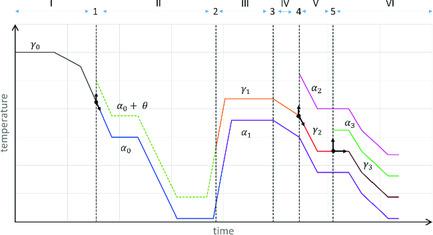当前位置:
X-MOL 学术
›
Steel Res. Int.
›
论文详情
Our official English website, www.x-mol.net, welcomes your feedback! (Note: you will need to create a separate account there.)
Simulation of Carbo‐Nitride Precipitation in the Multi‐Phase Microstructure of Micro‐Alloyed Transformation‐Induced Plasticity Steel
Steel Research International ( IF 2.2 ) Pub Date : 2020-09-08 , DOI: 10.1002/srin.202000197 Philipp Retzl 1, 2 , Walter Mayer 3 , Daniel Krizan 4 , Ernst Kozeschnik 1
Steel Research International ( IF 2.2 ) Pub Date : 2020-09-08 , DOI: 10.1002/srin.202000197 Philipp Retzl 1, 2 , Walter Mayer 3 , Daniel Krizan 4 , Ernst Kozeschnik 1
Affiliation

|
During the thermo‐mechanical treatment of low‐carbon transformation‐induced plasticity (TRIP) steel, precipitation of micro‐alloying carbo‐nitrides occurs in a complex microstructure consisting of various phases and mixtures of these, such as austenite, ferrite, pearlite, bainite, and/or martensite. In addition, the precipitation process is commonly stimulated and accelerated by plastic deformation that is induced by hot and warm rolling. In the present contribution, a method is suggested, which allows for a thermokinetics‐based simulation of the amount as well as the type and distribution of secondary precipitates depending on the local chemical and crystal environment of the polymorph microstructure. As basis of this study serves the thermokinetic software package MatCalc, it is used to simulate the evolution of precipitates during the entire steel processing route. According to the present simulation results, the distribution of C among individual precipitation domains, i.e., phases, is the most important factor governing the precipitate evolution in the system. In addition, the simulations show that niobium carbide (NbC) and vanadium carbide (VC) precipitates differ in their nucleation and growth behavior during the thermo‐mechanical treatment. While NbC nucleates mainly during the hot rolling process in a purely austenitic matrix, VC predominantly forms at lower temperatures in ferrite.
中文翻译:

微合金相变诱导塑性钢多相组织中碳氮化物沉淀的模拟
在低碳相变诱发塑性(TRIP)钢的热机械处理过程中,微合金化碳氮化物的析出发生在复杂的微观结构中,该微观结构由不同的相及其混合物组成,例如奥氏体,铁素体,珠光体,贝氏体和/或马氏体。另外,通常由热轧和热轧引起的塑性变形来刺激和加速沉淀过程。在当前的贡献中,提出了一种方法,该方法可以根据多晶型物微观结构的局部化学和晶体环境对次生沉淀物的数量以及类型和分布进行基于热动力学的模拟。作为这项研究的基础,我们提供了热动力学软件包MatCalc,它用于模拟整个钢加工过程中沉淀物的演变。根据目前的模拟结果,C在各个降水域(即相)之间的分布是控制系统中降水演变的最重要因素。此外,模拟结果表明,在热机械处理过程中,碳化铌(NbC)和碳化钒(VC)析出物的成核和生长行为不同。NbC主要在热轧过程中在纯奥氏体基体中成核,而VC主要在较低温度下在铁素体中形成。此外,模拟结果表明,在热机械处理过程中,碳化铌(NbC)和碳化钒(VC)析出物的成核和生长行为不同。NbC主要在热轧过程中在纯奥氏体基体中成核,而VC主要在较低温度下在铁素体中形成。此外,模拟结果表明,在热机械处理过程中,碳化铌(NbC)和碳化钒(VC)析出物的成核和生长行为不同。NbC主要在热轧过程中在纯奥氏体基体中成核,而VC主要在较低温度下在铁素体中形成。
更新日期:2020-09-08
中文翻译:

微合金相变诱导塑性钢多相组织中碳氮化物沉淀的模拟
在低碳相变诱发塑性(TRIP)钢的热机械处理过程中,微合金化碳氮化物的析出发生在复杂的微观结构中,该微观结构由不同的相及其混合物组成,例如奥氏体,铁素体,珠光体,贝氏体和/或马氏体。另外,通常由热轧和热轧引起的塑性变形来刺激和加速沉淀过程。在当前的贡献中,提出了一种方法,该方法可以根据多晶型物微观结构的局部化学和晶体环境对次生沉淀物的数量以及类型和分布进行基于热动力学的模拟。作为这项研究的基础,我们提供了热动力学软件包MatCalc,它用于模拟整个钢加工过程中沉淀物的演变。根据目前的模拟结果,C在各个降水域(即相)之间的分布是控制系统中降水演变的最重要因素。此外,模拟结果表明,在热机械处理过程中,碳化铌(NbC)和碳化钒(VC)析出物的成核和生长行为不同。NbC主要在热轧过程中在纯奥氏体基体中成核,而VC主要在较低温度下在铁素体中形成。此外,模拟结果表明,在热机械处理过程中,碳化铌(NbC)和碳化钒(VC)析出物的成核和生长行为不同。NbC主要在热轧过程中在纯奥氏体基体中成核,而VC主要在较低温度下在铁素体中形成。此外,模拟结果表明,在热机械处理过程中,碳化铌(NbC)和碳化钒(VC)析出物的成核和生长行为不同。NbC主要在热轧过程中在纯奥氏体基体中成核,而VC主要在较低温度下在铁素体中形成。



























 京公网安备 11010802027423号
京公网安备 11010802027423号